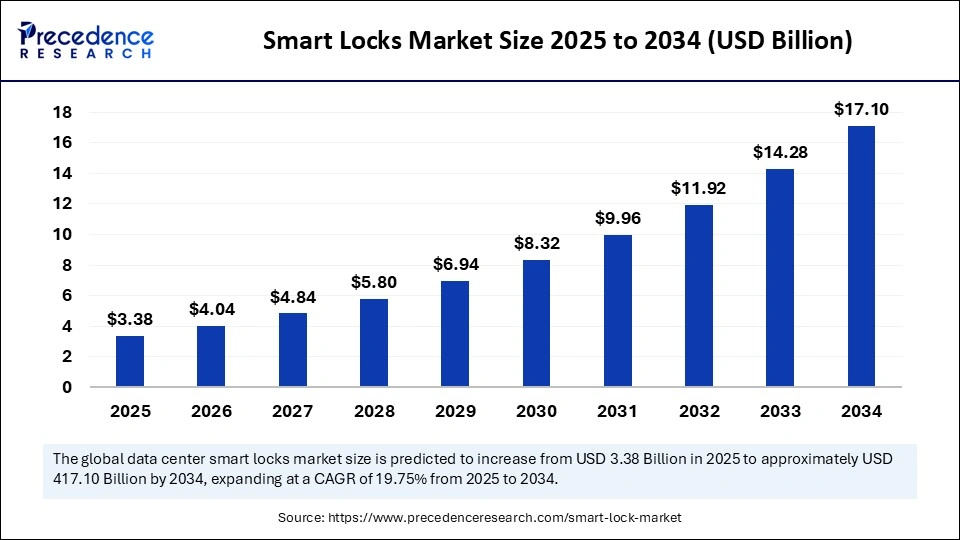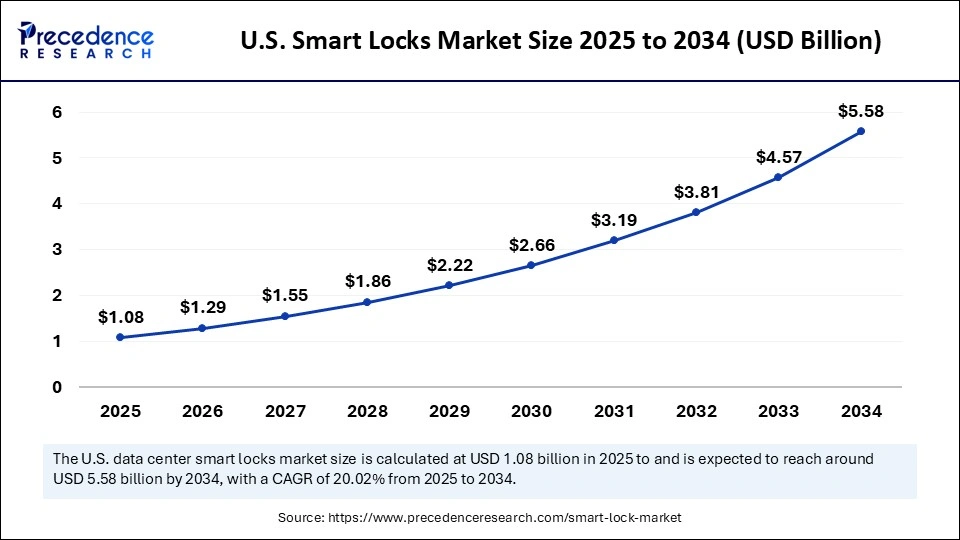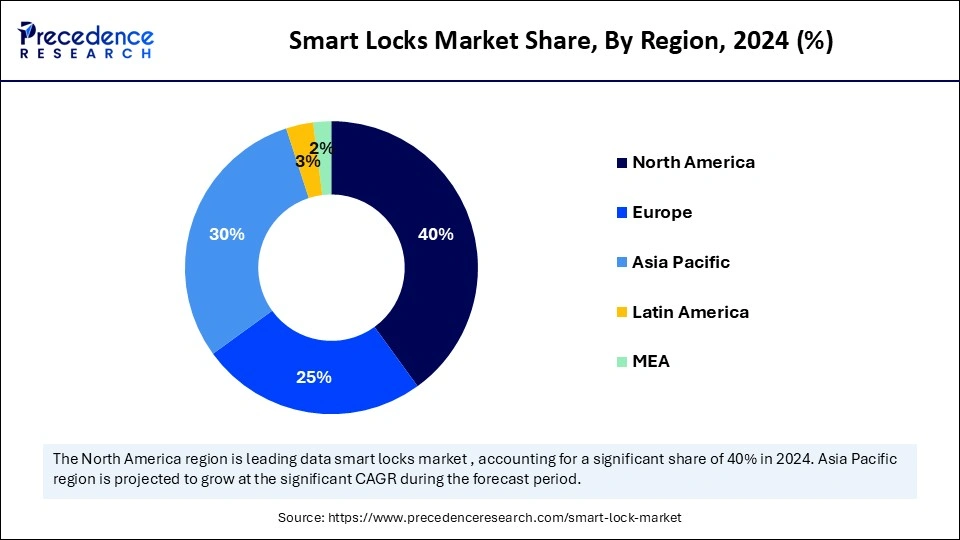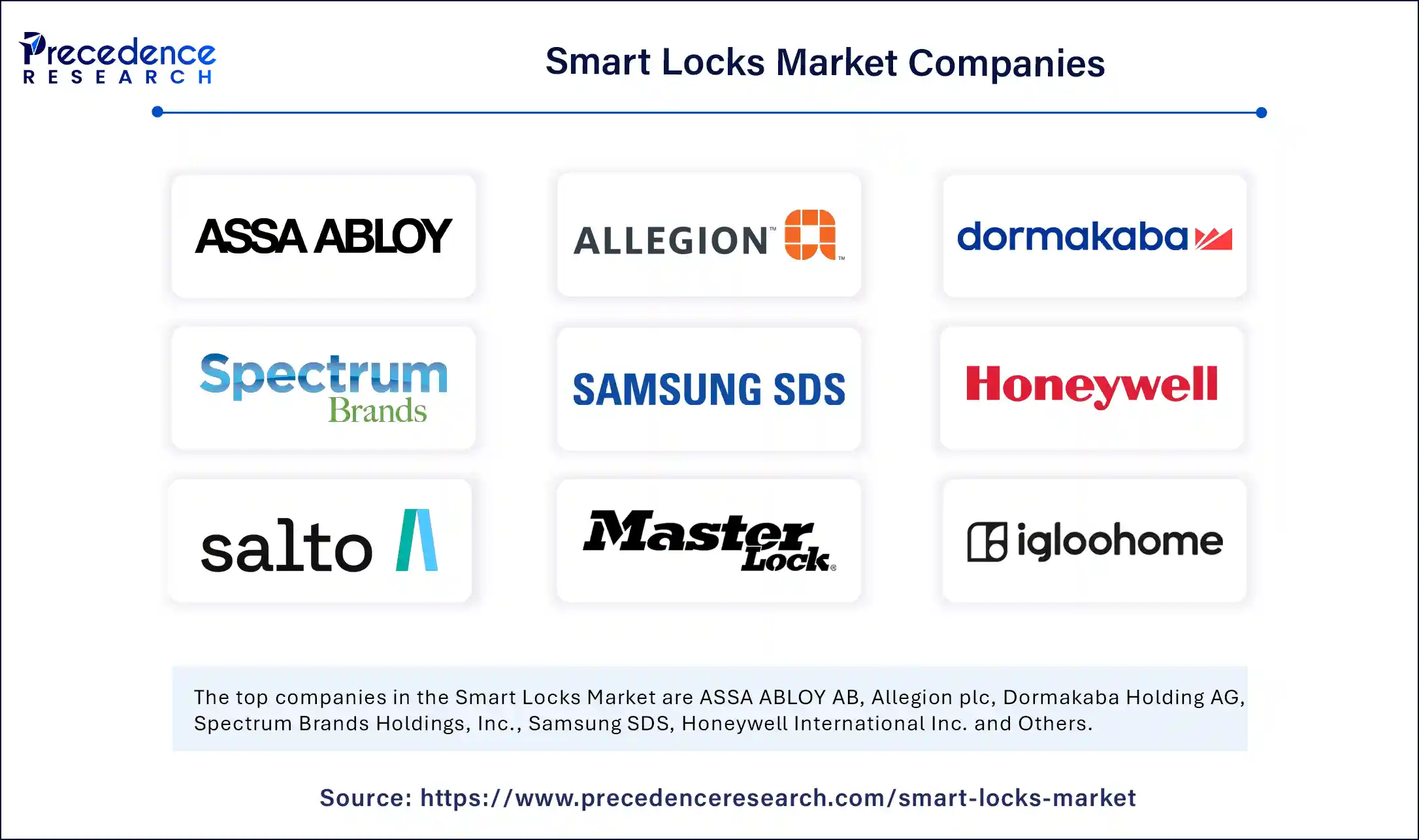List of Contents
What is the Smart Locks Market Size?
The global smart locks market size is accounted at USD 3.38 billion in 2025 and predicted to increase from USD 4.04 billion in 2026 to approximately USD 17.10 billion by 2034, expanding at a CAGR of 19.75% from 2025 to 2034. The increasing urbanization rate with government support, development of smart cities, and consumers' need for high-level home security in their absence, coupled with the introduction of various featured smart locks by leading marketers, is bolstering the market's growth globally.

Smart Locks Market Key Takeaways
- In terms of revenue, the global smart locks market was valued at USD 2.82 billion in 2024.
- It is projected to reach USD 17.10 billion by 2034.
- The market is expected to grow at a CAGR of 19.75% from 2025 to 2034.
- North America dominated the smart locks market with the largest market share of 40% in 2024.
- Asia Pacific is expected to witness the fastest CAGR during the foreseeable period.
- By lock type, the deadbolt locks segment captured the biggest market share of 40% in 2024.
- By lock type, the smart locks (hybrid/custom solutions) segment is expected to witness the fastest CAGR during the foreseeable period.
- By technology, the Bluetooth-enabled smart locks segment contributed the highest market share of 45% in 2024.
- By technology, the Wi-Fi-enabled smart locks segment is expected to witness the fastest CAGR during the foreseeable period.
- By authentication method, the mobile app/smartphone-based segment held the maximum market share of 50% in 2024.
- By authentication method, the biometric authentication segment is expected to witness the fastest CAGR during the foreseeable period.
- By application, the doors segment generated the major market share of 60% in 2024.
- By application, the cabinets segment is expected to witness the fastest CAGR during the foreseeable period.
- By end-use industry, the residential (smart homes, apartments) segment accounted for the significant market share of 55% in 2024.
- By end-use industry, the hospitality (hotels, resorts, airbnb) segment is expected to witness the fastest CAGR during the foreseeable period.
- By distribution channel, the offline sales (retail stores, distributors, specialty stores) segment held the largest market share of 65% in 2024.
- By distribution channel, the online sales (e-commerce, brand websites) segment is expected to witness the fastest CAGR during the foreseeable period.
Market Overview
The smart locks market refers to the design, production, and deployment of electronic locking systems that provide keyless entry and remote access control using smartphones, biometrics, RFID, Bluetooth, Wi-Fi, or IoT connectivity. Unlike traditional mechanical locks, smart locks offer convenience, enhanced security, integration with smart home ecosystems, and remote monitoring capabilities. The market is driven by rising adoption of smart homes, growing awareness of IoT security solutions, increased urbanization, and demand from residential, commercial, and hospitality sectors.
How is AI Transforming the Smart Locks Market?
Artificial intelligence integration with the smart locks sector is revolutionizing the market growth by allowing features such as customized access based on users' expectations, advanced security using biometric authentication, threat alerts in real time, and seamless home automation. AI also supports user experience by recording habit patterns, predicting their needs, and in-out times with anomaly detection, and improves security efficiently, making smart locks highly convenient and valuable. AI supports advanced biometrics systems like facial recognition, along with fingerprint scanning, which offers a highly advanced and personal user experience with security. AI can detect unusual activity like access after normal hours or access in an abnormal way, alerting consumers to potential threat messages.
What are the Key Trends in the Smart Locks Market?
- Smart home system with IoT integration: A significant trend that the smart locks market is witnessing includes the integration of IoT and other cutting-edge technologies with cameras, thermostats, and alarms for comprehensive security networks. Users can control their locks even remotely and keep monitoring them by using applications, and receive security alerts when someone intervenes illegally at unexpected times. This creates a sense of security and enhances confidence to use such technologies in broader smart home ecosystems.
- Biometric and keyless entry: Another significant trend for the market's growth is the use of biometric technologies like fingerprint scanning and facial recognition. It has become highly precise and user-friendly, offering enhanced security as compared to conventional keys. Also, the increasing demand for contactless solutions with a convenience keyless entry option is another reason why the market is expanding rapidly.
Market Scope
| Report Coverage | Details |
| Market Size by 2034 | USD 17.10 Billion |
| Market Size in 2025 | USD 3.38 Billion |
| Market Size in 2026 | USD 4.04 Billion |
| Market Growth Rate from 2025 to 2034 | CAGR of 19.75% |
| Dominating Region | North America |
| Fastest Growing Region | Asia Pacific |
| Base Year | 2024 |
| Forecast Period | 2025 to 2034 |
| Segments Covered | Lock Type, Technology, Authentication Method, Application, End-Use Industry, Distribution Channel, and Region |
| Regions Covered | North America, Europe, Asia-Pacific, Latin America, and the Middle East & Africa |
Market Dynamics
Drivers
Growing Urbanization with Smart Homes
A major driving factor for the smart locks market expansion is the increasing rate of urbanization due to a burgeoning population across the globe seeking modern residential spaces to live comfortably. More people are interested in buying a premium house with technically advanced features integrated into it, popularly known as a smart home. This adoption is directly affecting the demand for smart locks, which is a natural fit for technologically sounded buildings with security and citizen safety. Also, the smart city concept target to manage city assets and services more efficiency. Governments are actively working to build smart city projects, such as India's smart city mission, which promote the integration of various technologies, stimulating market growth.
Restraint
Cybersecurity Concern
Despite having notable benefits of smart locks to build a smart home ecosystem, there are some drawbacks, like smart locks being vulnerable to unauthorized access and hacking, raising concerns about user privacy and the possibility of misuse. Smart locks can collect and rely on data due to their internal connection with every device in the smart home, which allows cybercriminals to easily access the password of the targeted home. Also, many smart homes depend on batteries and external power, which makes them susceptible to tampering and battery failure.
Opportunity
AI Behavioral Analytics
AI-powered locks can continuously monitor and analyze data by using AI models that analyze user interactions continuously and the environment around them to gain detailed data, creating a lucrative opportunity to strengthen the smart locks market by offering anomaly detection and automated response. AI changes the security level from a reactive base model to a proactive one. The system can detect unauthorized login instantaneously and prevent further loss before it escalates. Such a high level of security is beneficial for short-term rentals, the commercial sector, and multi-tenant housing, which further stimulates the demand for smart lock systems.
Lock Type Insights
Why are Deadbolt Smart Locks Preferred for Smart Home Development?
The deadbolt locks segment held the largest market share of nearly 40% in 2024. Deadbolts have a solid metal bolt that extends deep into the door frame, offering solid resistance against forced entry, making it a highly reliable lock type for many consumers in their commercial and residential settings. They offer easy installation due to their designs, whether as a complete replacement or retrofit of a smart module. Its high security perception makes it highly popular to integrate with smart home systems.
The smart locks (hybrid/custom solutions) segment is expected to witness the fastest CAGR during the foreseeable period. The segment is growing significantly due to increased security concerns and needs robust solutions like fingerprint scanning and facial recognition, and enhanced reliability with multiple unlocking systems by using smartphone applications. It offers robust security against conventional vulnerabilities.
Technology Insights
How do Bluetooth-enabled Locks Support the Smart Locks Market Growth?
The Bluetooth-enabled smart locks segment held the largest market share of nearly 45% in 2024. Bluetooth has a low energy consumption technology, which is cost-effective and leads to very little power usage with longer battery life and fewer needs to replace batteries. Bluetooth offers a direct and reliable connection between the user's smartphone and the lock. This approach makes it easy to control via dedicated applications without the need for complex technologies.
The Wi-Fi-enabled smart locks segment is expected to witness the fastest CAGR during the foreseeable period. Wi-fi is well well-established standard in many homes, offering a smart lock to easily connect with existing networks without the need for an additional gateway. Users can control the locking system even remotely is its major driving factor.
Authentication Insights
How are Smartphone-Based Applications Utilized Mostly in the Smart Locks Market?
The mobile app/smartphone-based segment held the largest market share of nearly 50% in 2024. The widespread adoption of smartphones offers a readily available platform that can be seamlessly integrated and used for a smart lock system, making it highly accessible for commercial and residential use for daily convenience. Also, mobile applications support advanced features like virtual key sharing and real-time activity logs to track when someone enters and at what time they leave, giving a sense of security.
The biometric authentication segment is expected to witness the fastest CAGR during the foreseeable period. The segment is proliferating due to its increased demand for higher security and its reliable functionality by using facial recognition and fingerprint scanning. It further offers great user convenience with keyless and faster access without fear of losing physical keys.
Application Insights
How Smart Locks can be Integrated into Doors with Precise Application in the Smart Lock Market?
The doors segment held the largest market share of nearly 60% in 2024. The broader trend of integrating smart locks with doors makes it a natural and crucial component that supports connected living with high security. Doors are generally used as the main entry point in the house, making it vulnerable to potential threats from unauthorized access. Hence, doors are mainly used for applications of smart locks, fueling the smart locks market growth with its growing demand globally, especially in smart urban cities.
The cabinets segment is expected to witness the fastest CAGR during the foreseeable period. The increasing demand for reliable and enhanced security features like smart locks for residential and commercial spaces supports the smart home adoption with a smart lock system as per evolving consumers' needs.
End-use Industry Insights
Why have Residential Users Found Maximum Application of Smart Locks?
The residential (smart homes, apartments) segment held the largest market share of nearly 55% in 2024. The homeowners are seeking a high level of security, in the absence of which, increases the popularity of smart locks in residential spaces. It offers unparalleled convenience like keyless entry, remote control for locking/unlocking door in case of emergency, and temporary access for visitors or family members has significantly improved a user's experience.
The hospitality (hotels, resorts, airbnb) segment is expected to witness the fastest CAGR during the foreseeable period. Smart locks increase guest comfort by offering automatic keyless entry with mobile-based access and enhanced operational efficiency for hotel owners and visitors, also with remote monitoring control features.
Distribution Channel Insights
Why are Offline Sales Preferred in the Smart Locks Market?
The offline sales (retail stores, distributors, specialty stores) segment held the largest market share of nearly 65% in 2024. Offline sales provide the ability for buyers to check product quality closely, receive easy installation services at a reasonable price or discounts, and after-sales service facilities, in case of damage. Storefronts provide direct and in-person support by allowing consumers to satisfy their doubts about smart locks and their application, and how they can be handled, making it a highly reliable method to buy smart locks.
The online sales (e-commerce, brand websites) segment is expected to witness the fastest CAGR during the foreseeable period. The segment is expanding significantly due to increasing demand for smart locks across various regions, coupled with the expansion of e-commerce platforms that have made such smart locks with consumers. Online sales offer high-level comfort by providing the required amount of smart lock at the door without the need for the consumer's physical presence. It is highly desirable in developing areas.
Regional Insights
U.S. Smart Locks Market Size and Growth 2025 to 2034
The U.S. smart locks market size was evaluated at USD 1.08 billion in 2025 and is projected to be worth around USD 5.58 billion by 2034, growing at a CAGR of 20.02% from 2025 to 2034.

How is the North America Smart Locks Market Growing Dominantly Across the Globe?
North America held the largest market share of nearly 40% in 2024. The region's growth can be attributed to factors like increasing demand for home automation and robust security using cutting-edge technologies and innovations presented by leading companies to support smart home technology further. Many consumers are prioritizing advanced security features, comfort, and integration with different smart devices like thermostats and lighting. High disposable income in this region is another major driver for the market's expansion. Moreover, the region boasts advanced technological infrastructure with high internet connectivity and widespread adoption of smartphones, which is crucial for the functioning of Wi-Fi and Bluetooth-enabled smart locks. Present of leaders in the smart locks market to assist advanced home technology, which drives further expansion of the market.

Which Factors Support the Asia Pacific Smart Locks Market Growth?
Asia Pacific is expected to witness the fastest CAGR during the foreseeable period of 2025-2034. The region's growth is attributed to various factors like increasing urbanization and smart home adoption in leading countries, increasing disposable income, growth of smartphone usage, and IoT penetration. Initiatives by governments in the Asia Pacific to build smart cities with advanced security systems, which directly support the demand for smart locks, are further. Economically developing countries like India, China, and South Korea are witnessing significant growth in the demand for smart locks due to increasing investment by people in smart homes and robust commercial infrastructure backed by recent technologies. Consumers are increasingly adopting keyless entry options for more comfort with high-level security features, further expanding the market's growth.
Value Chain Analysis
- Product Conceptualization and Design
This stage focuses on finding market trends, requirements, and developing product specifications with detailed designs needed for robust hardware and software to support the growth of the smart locks market.
Key Players:Allegion, Dormakaba, HavenLock, and Avent Security.
- Raw Material Procurement
This stage involves sourcing high-quality materials with various crucial devices and small components from authentic providers that ensure functionality, durability, and cost-effectiveness for smart locks.
Key Players:Welmade Locking System Pvt. Ltd, Sherani Locks Manufacturers Pvt Ltd.
- Manufacturing and Assembly
This stage encompasses collecting various crucial components and assembling them together, including PCB assembly, software programming, and other crucial factors, along with rigorous testing and quality control.
Key Players:Godrej Group, ASSA ABLOY, Dormakaba Group.
Smart Locks Market Companies

- ASSA ABLOY AB (Yale, August)
- Allegion plc (Schlage, LCN)
- Dormakaba Holding AG
- Spectrum Brands Holdings, Inc. (Kwikset, Weiser)
- Samsung SDS
- Honeywell International Inc.
- Salto Systems S.L.
- Master Lock (Fortune Brands Innovations)
- Igloohome Pte Ltd.
- HavenLock Inc.
- Lockly Inc.
- Nuki Home Solutions GmbH
- Vivint Smart Home, Inc.
- Den Smart Home
- Xiaomi Corporation
Recent Developments
- In February 2025, Salto Systems launched an advanced smart lock solution- XS4 one S keypad, which can integrate with PIN codes, smart keycards, and mobile access. It offers a flexible and secure entry experience while ensuring intuitive operations with its unparalleled features.(Source: https://saltosystems.com)
- In April 2024, a leading market player, Onity, which offers electronic access solutions and mobile credentialing to several industries, along with self-storage has announced that they were going to integrate sensors into its passport smart locks that can identify temperature, motion, water, and more. This locking solution has a gateway that enables facility owners and managers to gain and transmit data from the sensors to the pass portal cloud-based management system offered by Onity.(Source: https://www.modernstoragemedia.com)
Segments Covered in the Report
By Lock Type
- Deadbolt Locks
- Lever Handle Locks
- Padlocks
- Rim/Mortise Locks
- Smart Locks (Hybrid/Custom Solutions)
By Technology
- Bluetooth-Enabled Smart Locks
- Wi-Fi-Enabled Smart Locks
- Z-Wave and Zigbee Locks
- Biometric Locks (Fingerprint, Facial Recognition)
- RFID/NFC Locks
By Authentication Method
- Biometric (Fingerprint, Facial, Iris)
- PIN Code/Keypad
- Mobile App/Smartphone-Based
- RFID Card/Fob
- Hybrid/Multi-Factor Authentication
By Application
- Doors
- Cabinets
- Safes/Lockers
- Other Access Points
By End-Use Industry
- Residential (Smart Homes, Apartments)
- Commercial (Offices, Retail, Banks)
- Hospitality (Hotels, Resorts, Airbnb)
- Industrial (Warehouses, Data Centers)
- Government and Defense
By Distribution Channel
- Online Sales (E-commerce, Brand Websites)
- Offline Sales (Retail Stores, Distributors, Specialty Stores)
By Region
- North America
- Europe
- Asia-Pacific
- Latin America
- Middle East and Africa
For inquiries regarding discounts, bulk purchases, or customization requests, please contact us at sales@precedenceresearch.com
Frequently Asked Questions
Ask For Sample
No cookie-cutter, only authentic analysis – take the 1st step to become a Precedence Research client